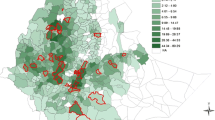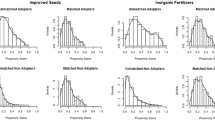Abstract
This paper investigates impact heterogeneity in the adoption of improved maize varieties using data from rural Tanzania. We used a generalized propensity-score matching methodology, complemented with a parametric econometric method to check the robustness of results. We found a consistent result across models, indicating that adoption increased food security, and that the impact of adoption varied with the level of adoption. On average, an increase of one acre in the area allocated to improved maize varieties reduced the probabilities of chronic and transitory food insecurity from between 0.7 and 1.2 % and between 1.1 and 1.7 %, respectively. Policies that increase maize productivity and ease farmers’ adoption constraints can ensure the allocation of more land to improved technologies and, in doing so, enhance the food security of households.


Similar content being viewed by others
Notes
We thank the anonymous referee for suggesting this analysis.
It should be kept in mind that the GPS score methods are designed for analyzing the effect of a treatment level, therefore they specifically refer to the subpopulation of treated units/adopters. This implies that including untreated units might lead to misleading results (Guardabascio and Ventura 2013). Accordingly, in the GSP and dose–response estimation we only considered positive observations.
Though variables explaining the potential endogenous variables such as the use of fertilizer and other crop improved varieties are included in the regression models, we estimated the models including and excluding these potential endogenous regressors; however, we only report results including potential endogenous variables to save space and because the food security impact results are numerically close. The average marginal effects were −2.7 %, −1.2 %, −1.1 %, 1.5 % and 0.9 % for chronic food insecurity, transitory food insecurity, breakeven, and food-surplus in food security, respectively. The average marginal effect for per capita food consumption was 14,701 TSH.
References
Alene, A. D., Menkir, A., Ajala, S. O., Badu-Apraku, A. S., Olanrewaju, V., Manyong, M., et al. (2009). The economic and poverty impacts of maize research in West and Central. Agricultural Economics, 40, 535–550.
Amare, M., Asfaw, S., & Shiferaw, B. (2012). Welfare impacts of Maize-Pigeonpea intensification in Tanzania. Agricultural Economics, 43(1), 1–17.
Asfaw, S., Kassie, M., Simtowe, F., & Leslie, L. (2012a). Poverty reduction effects of agricultural technology adoption: a micro-evidence from Rural Tanzania. Journal of Development Studies, 48(9), 1288–1305.
Asfaw, S., Shiferaw, B., Simtowe, F., & Lipper, L. (2012b). Impact of modern agricultural technologies on smallholder welfare: evidence from Tanzania and Ethiopia. Food Policy, 7(3), 283–295.
Becerril, J., & Abdulai, A. (2010). The impact of improved maize varieties on poverty in Mexico: a propensity score matching approach. World Development, 38(7), 1024–1035.
de Janvry, A., & Sadoulet, E. (2001). World poverty and the role of agricultural technology: direct and indirect effects. Journal of Development Studies, 38(4), 1–26.
Deaton, A. (2010). Price indices, inequality, and the measurement of world poverty. Presidential Address, American Economic Association, January, Atlanta.
Djebbari, H., & Smith, J. (2008). Heterogeneous impacts in PROGRESA. Journal of Econometrics, 145, 64–80.
Pender, J., & Gebremedhin, B. (2007). Determinants of agricultural and land management practices and impacts on crop production and household income in the highlands of Tigray, Ethiopia. Journal of African Economies, 17, 395–450.
Guardabascio, B., & Ventura, M. (2013). Estimating the dose—response. Function through a GLM Approach. German Stata Users’ Group meetings 2013, Stata Users Group.
Hirano, K., & Imbens, G. W. (2004). The propensity score with continuous treatments. In A. Gelman & X. Meng (Eds.), Applied bayesian modeling and causal inference from incomplete-data perspectives. New York: Wiley.
Høgh-Jensen, H., Myaka, F. A., Sakala, W. D., Kamalongo, D., Ngwira, A., Vesterager, J. M., et al. (2007). Yields and qualities of pigeonpea varieties grown under smallholder farmers’ conditions in Eastern and Southern Africa. African Journal of Agricultural Research, 2(6), 269–278.
Kabubo-Mariara, J., Linderhof, V., Kruseman, G., Atieno, R., & Mwabu, G. (2006). Household welfare, investment in soil and water conservation, and tenure security: Evidence from Kenya. Poverty Reduction and Environmental Management (PREM) Working Paper 06–06.
Kassie, M., Simon, W., & Jesper, S. (2014). What determines gender inequality in Household Food security in Kenya? Application of exogenous switching regression. World Development, 56, 153–171.
Kassie, M., Jaleta, M., Shiferaw, B., Mmbando, F., & Mekuria, M. (2013). Adoption of interrelated sustainable agricultural practices in smallholder system: evidence from rural Tanzania. Technological Forecast and Social Change, 80, 525–540.
Kassie, M., Shiferaw, B., & Geoffrey, M. (2011). Agricultural technology, crop income, and poverty alleviation in Uganda. World Development, 39(10), 1784–1795.
Karanja, D. D., Renkow, M., & Crawford, E. W. (2003). Welfare effects of maize technologies in marginal and high potential regions of Kenya. Agricultural Economics, 29(3), 331–341.
Kijima, Y., Otsuka, K., & Serunkuuma, D. (2008). Assessing the impact of NERICA on income and poverty in central and western Uganda. Agricultural Economics, 38(3), 327–337.
Kluve, J., Schneider, H., Uhlendorff, A., & Zhao, Z. (2012). Evaluating continuous training programmes by using the generalized propensity score. Journal of Royal Statistical Society, 175(Part 2), 587–617.
Mallick, D., & Rafi, M. (2010). Are female-headed households more food insecure? Evidence from Bangladesh. World Development, 38(4), 593–605.
Minten, B., & Barrett, C. B. (2008). Agricultural technology, productivity, and poverty in Madagascar. World Development, 36(5), 797–822.
Minot, N. (2010). Staple food prices in Tanzania. Contributed Paper Prepared for the COMESA Policy Seminar Maputo, Mozambique, 25–26 January.
Ravallion, M., & Lokshin, M. (2002). Self-rated economic welfare in Russia. European Economic Review, 46(8), 1453–1473.
Rosenbaum, P. R., & Rubin, D. B. (1983). The central role of the propensity score in observational studies for causal effects. Biometrika, 70(1), 41–55.
Smale, M., Byerlee, D., & Jayne, T. (2011). Maize revolutions in Sub-Saharan Africa. World Bank Policy Research working paper. No. WPS 5659.
Wooldridge, J. (2002). Econometric analysis of cross section and panel data. Cambridge: MIT Press.
USDA (United States Department of Agriculture) (2010). Foreign Agricultural service supply and distribution (PSD) online database. http://www.fas.usda.gov/psdonline/psdHome.aspx. Accessed on December 2010.
Acknowledgement
This study is supported by the Australian Centre for International Agricultural Research (ACIAR) and the Australian International Food Security Research Centre (AIFSRC) through the International Maize and Wheat Improvement Center (CIMMYT)-led Sustainable Intensification of Maize-Legume Cropping Systems in Eastern and Southern Africa (SIMLESA) program, and Adoption Pathways Project. The views expressed here are those of the authors and do not necessarily reflect the views of the donor or the authors’ institution. The usual disclaimer applies. We would also like to thank the anonymous reviewer and the chief editor of this journal for their valuable comments and suggestions which improved the quality of the paper.
Author information
Authors and Affiliations
Corresponding author
Rights and permissions
About this article
Cite this article
Kassie, M., Jaleta, M. & Mattei, A. Evaluating the impact of improved maize varieties on food security in Rural Tanzania: Evidence from a continuous treatment approach. Food Sec. 6, 217–230 (2014). https://doi.org/10.1007/s12571-014-0332-x
Received:
Accepted:
Published:
Issue Date:
DOI: https://doi.org/10.1007/s12571-014-0332-x




